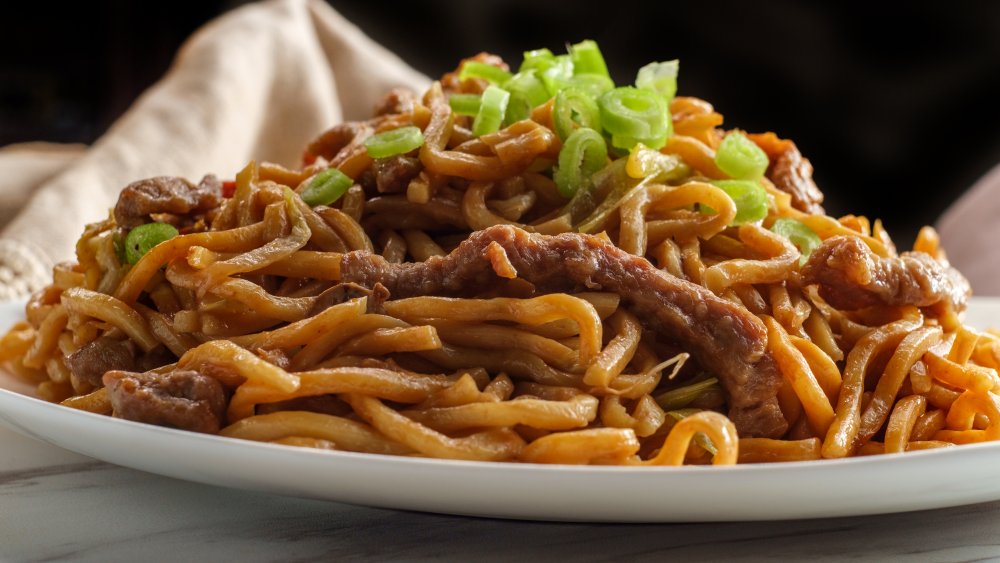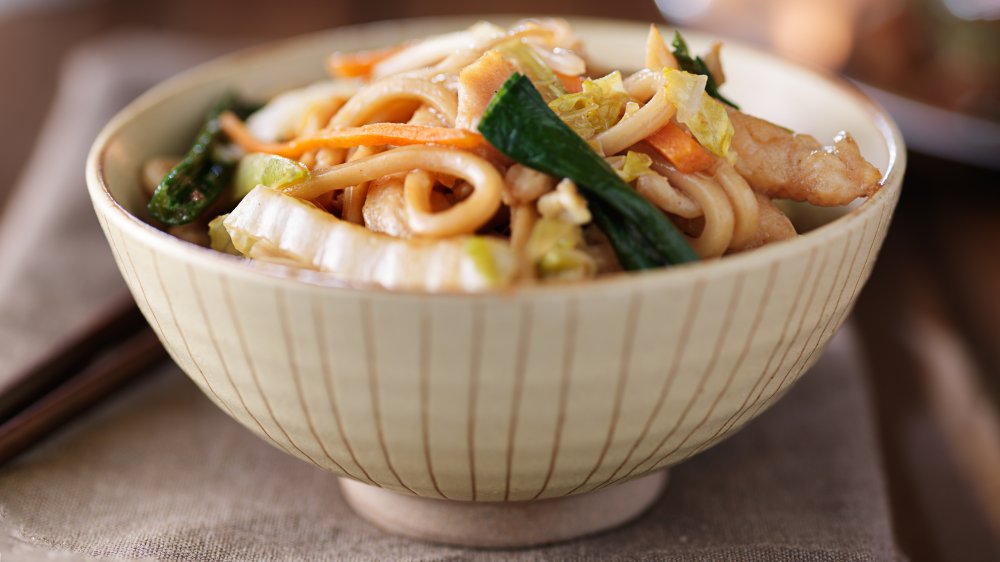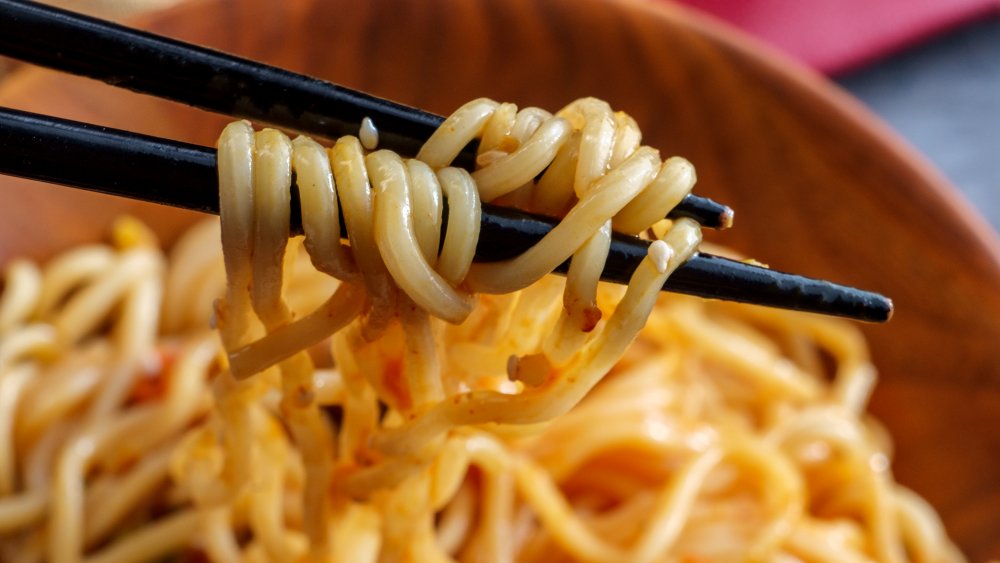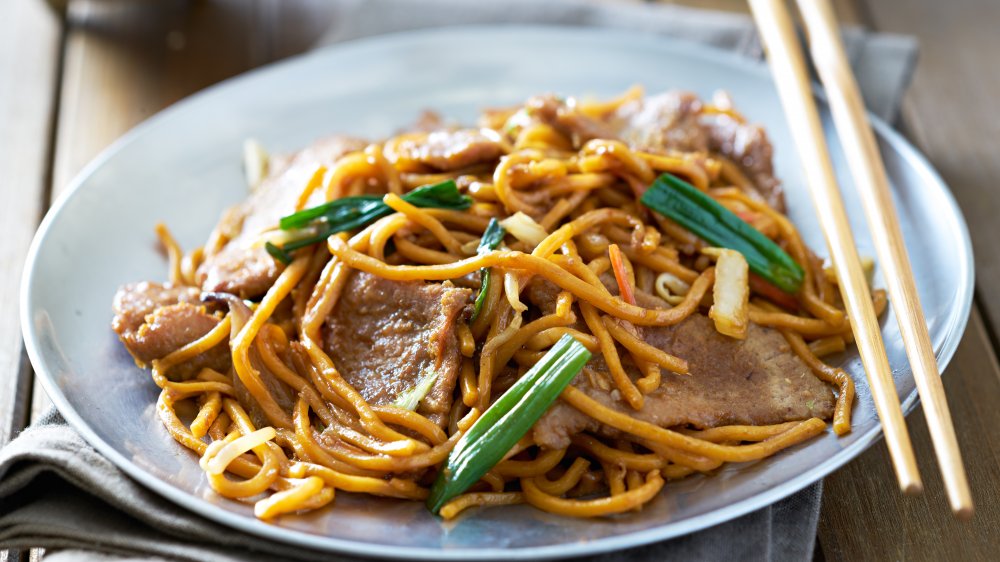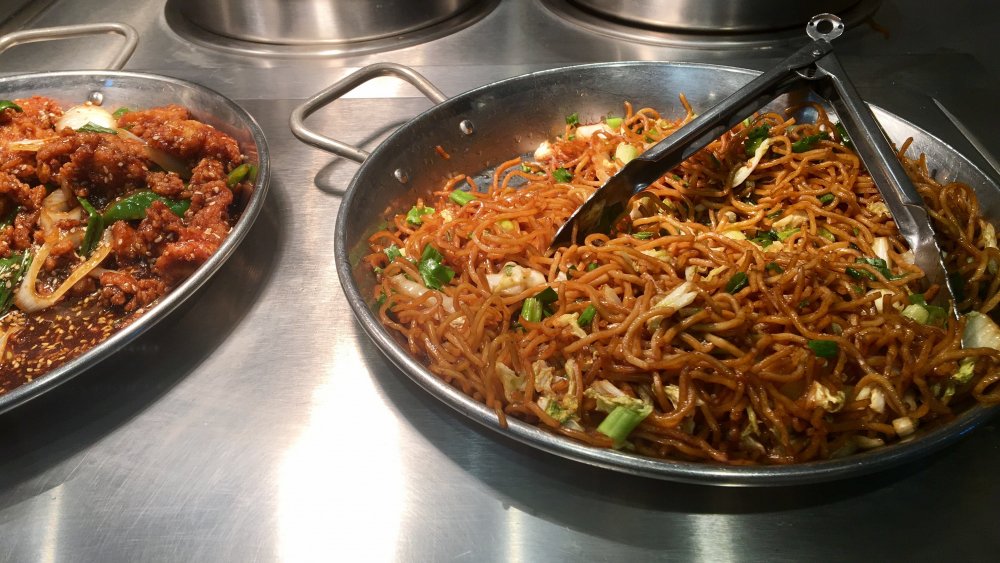You Should Never Get Lo Mein At A Chinese Restaurant. Here's Why
Lo mein may be the perfect Chinese comfort food — slightly sweet, a little bit sticky, not too spicy, but oh-so-satisfying. You can pair it with any beverage from Coke to dry white wine to jasmine tea, and if you can't scarf down a whole plateful in one sitting — it is super-filling, after all — the leftovers seem to taste even better the next day, even (or perhaps especially) if you eat them straight from the carton, still cold from the refrigerator.
Still, as yummy and tempting as lo mein may be, it's really not something you should be ordering from a Chinese restaurant. For one thing, lo mein as we know it isn't even remotely authentic, not even a little bit, nor is it anything approaching nutritious. Lo mein is also much cheaper, and far better, if you can make it yourself.
American lo mein is nothing like its Chinese counterpart
If you want to order the most authentic item on the menu, lo mein isn't the dish for you. While lo mein, unlike General Tso's chicken, isn't entirely unknown in China, the Chinese version is quite different from the one we know. "Lo mein" actually means "stirred noodles" and refers to a method of preparation rather than a specific dish. According to My Great Recipes, the Chinese preparation method involves stirring noodles into a soup broth just before it finishes cooking so the noodles become soft and absorb the flavor of the broth and its seasonings.
ChowHound further explains the differences between lo mein as it might be served in Boston and Beijing. In the U.S., lo mein noodles are tossed in a hot wok with a thick brown sauce made from ingredients such as chicken broth, soy sauce, hoisin, ginger, oyster sauce, sesame oil, rice wine, and cornstarch. The protein comes from pork, chicken, beef, or sometimes seafood (unless it's a veggie version).
Chinese lo mein noodles are also stir-fried in a wok, but the sauce is lighter and thinner, perhaps made with just soy and rice vinegar with just a tiny bit of thickener. Chinese lo mein may be topped with beef brisket or even wontons, or else the meat — along with vegetables such as mushrooms and bok choy — may be served alongside the noodles instead of being mixed in as is more typical with the U.S. version.
It's just not healthy
Lo mein as we know is basically a heaping helping of carbs plus a whole lot of oil. If you order it from popular American Chinese chain P.F. Chang's, even the veggie version has 630 calories, 10 grams of fat, and 114 grams of carbs. Adding fatty meat like pork really takes it over the top, however, with 920 calories and 32 fat grams, although if it's any slight consolation, this version only has 112 grams of carbs.
Also, if you're watching your sodium intake, you might want to look away from lo mein — salty soy sauce boosts the sodium content to 3540 mg for the veggie, and a whopping 4170 for the shrimp version. Sugar content isn't looking good, either — 20 grams for each type of lo mein except veggie, which tops out at 23.
If you're wondering how this compares to the Recommended Daily Values based on 2,000 calories per day, the pork lo mein will deliver nearly half of your daily allowed 78 fat grams, and all the lo mein entrees offered will give you more than 1/3 of your 275 grams of carbs. You'll be nearly halfway to your permitted 50 grams of sugar, but – oopsie! – way over the top on sodium, since you should really only be consuming 2,300 grams or fewer per day of that particular nutrient (via VeryWellFit).
Lo mein is not worth the cost
CheatSheet lists lo mein as one of the top Chinese restaurant menu items that are a complete waste of money. It's true that at most restaurants the dish consists primarily of noodles, which are one of the cheapest items in a restaurant kitchen. What's more, they can be bulked up with inexpensive veggies such as cabbage, while the pricier proteins — pork, beef, chicken, shrimp — are in sparse supply.
Lo mein is actually a cost-effective way for restaurants to skimp on serving anything that's actually going to cost them money while getting rid of any veggies they may have overstocked. While that's nice for the restaurant owners, why should you be the one helping their bottom line? If you order something like hot pot instead, you'll see exactly how much meat and you're getting instead of having it be buried under a pile of noodles.
Lo mein is easy to make at home
If you want to enjoy a healthier version of lo mein for a lot less money than it will cost you in a restaurant — and for a little more trouble than it will take you to order takeout — it's really quite a simple dish to make. Epicurious suggests using any type of round noodle in place of Chinese egg noodles if the latter is hard to come by.
You really won't need any complicated ingredients for the sauce, either — their recipe calls for soy sauce (you can opt for a low sodium version), oyster sauce, rice wine or dry sherry, honey, peanut or vegetable oil, garlic, ginger, and scallions, with mushrooms for the veggies and roast pork or other meat of choice (leftover rotisserie chicken would be another effortless option) for the protein. Even the wok is optional, as any large skillet will do. Perhaps 15 or 20 minutes from the time you start boiling the water to cook the noodles to the time dinner is done, and it will be more than worth the minimum effort you put into it.
